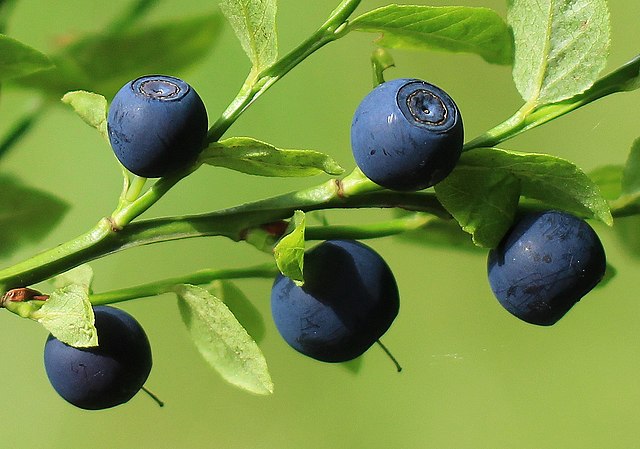Blueberries:
What are they?, history, cultivation, nutritional value, uses, recipes, and more...
Blueberries are small, spherical berries with dark blue or red color and a tart taste. They are considered one of the healthiest fruits due to their high antioxidant content, anti-inflammatory properties, cardiovascular benefits, low calorie content, among others.
Índice
What are Blueberries?
Blueberry is a plant of unknown origin that primarily grows spontaneously in northern Europe, Asia, and America. It is believed to be native to Europe, northern Africa, the Caucasus, and northern Asia.
Blueberry is a small deciduous shrub that can reach up to 1 meter in height, although it varies depending on the species. It has a composite root system, mostly superficial. These roots are usually fibrous, thin, and lack absorbing hairs. The blueberry stem is small, underground, straight, square, and highly branched. It generally has a brown-orange color, depending on the species.
Its branches are angular and green, and it has oval, alternate, leathery leaves that are light green or yellowish with finely toothed margins. The leaves are deciduous and have short petioles. The flowers are small, axillary, and come in clusters of 6-10 flowers per bud. The calyx is composed of 4-5 sepals and petals, and they have a pinkish-green color. The fruit is a spherical, fleshy berry that turns blue, red, or black when ripe, depending on the species. They measure between 6 and 10 millimeters and have a pleasant tart taste.
Blueberries can be found in abundance in clearings of coniferous forests, such as wild pines or firs, in heaths and mountain shrubs, between 900 and 2,700 meters above sea level. Their fruits are a key food source for many animals in the wild, from birds of various sizes to mammals like the brown bear.
Currently, Peru is the world’s leading exporter of fresh blueberries for the second consecutive season, with a total of 162,459 tons exported in the 2020-2021 period, amounting to US$1 billion.
History of Blueberries
Blueberries have been harvested by Native Americans for hundreds of years, long before the arrival of the Pilgrims. Native Americans burned vegetation areas, including where blueberries grew, to regenerate crop vigor and eliminate competition. It is also known that the Narragansett and Wampanoag tribes gathered these wild berries for consumption in a concentrated and nutritious meal called Pemmican, which was made with meat and fat.
European settlers incorporated these berries into their diet, including them in cranberry sauce used on Thanksgiving.
In Peru, blueberry cultivation started modestly in some productive areas of the country. The first recorded plantation dates back to 2008 in Arequipa, with 10 hectares and 100,000 plants, most of which died shortly after being planted. Since then, the situation has changed dramatically, to the point that today we are the largest exporter of blueberries worldwide.

Common Name of Blueberry
| Español | Anabia, anavia, arandanera, arándano, arandaño, arandaño, arandeira, arandilla, arando, arañón, argoma, arándano, arráspano, caramiña, caramina, manzanilleta, méndero, meruéndano, mirtillo, mirtilo, mirtilos, mortiños, murtilo, navia, obi, oliveta de puerto, raspanera, raspaneta, raspanicera, raspaniza, raspanorio, raspona, rasponera, ráspano, ráspano negro, ráspanu, uva do monte. |
| Alemán | blaubeere, Augleinbeere, Krähenauge |
| Inglés | Blueberry |
| Danés y noruego | blåbaer |
| Sueco | blåbär |
| Holandés | blauwe bosbes |
| Frances | myrtille |
| Ruso | tchernika |
| Italiano | mirtillo |
| Portugués y gallego | arandeira |
| Catalán | nabiu |
| Euskera | ahabia |
Scientific Name of Blueberry
Vaccinium myrtillus
Taxonomy of Blueberry
| Reino | Plantae |
| División | Magnoliophyta |
| Clase | Magnoliopsida |
| Orden | Ericales |
| Familia | Ericaceae |
| Subfamilia | Vaccinioideae |
| Tribu | Vaccinieae |
| Género | Vaccinium |
| Especie | Vaccinium myrtillus |
Synonymy of Blueberry
- Vaccinium myrtillus var. leucocarpum Hausm. 1852
- Vaccinium myrtillus var. anomalum Rouy 1908
- Vitis-Idaea myrtillus (L.) Moench 1794
- Vaccinium montanum Salisb. 1796
- Vaccinium angulosum Dulac 1867
- Myrtillus sylvatica Drejer 1838
- Myrtillus nigra Gilib.
- Myrtillus sylvaticus Drejer
- Vaccinium myrtillus var. minoriflora Sennen & Elías in Sennen
Etymology of Blueberry
Vaccinium: It is the generic name used in classical Latin for a type of berry (probably the blueberry Vaccinium myrtillus). Do not confuse it with the word vaccinum, which means “of or belonging to cows.”
Myrtillus: It is the Latin diminutive epithet that means “blueberry” or “small myrtle.”
Habitat of Blueberry
- Habitat
Habitat of Blueberry
Although the exact place of origin of blueberries is not known for certain, it is believed that they originated in the northern regions of Europe, North America, and Asia. Blueberries can also be found in North and South America, where they are cultivated in plantations and nurseries in Chile, Argentina, and Peru, in high-altitude areas and the Andean valley.
Blueberries thrive in temperatures ranging from 16-25ºC, although they can tolerate temperatures as low as -30ºC.
Their cultivation requires relatively high humidity, light soils with good drainage and high organic matter content.
Regarding pH, it should be acidic, with the optimal range being between 4.3-4.8. A pH above 5 can result in poor development in young plantations and chlorotic shoots. However, a low pH (below 4) can lead to manganese toxicity.
Localized irrigation is recommended, using good-quality water without salinity or excess calcium, boron, or chlorine.
Generally, blueberries are propagated vegetatively. Seed propagation is only carried out for the purpose of researching new varieties.
Fruit harvesting begins when 10-15% of the fruits are ripe, and the sugar content is above 11ºBrix. Harvesting is done gradually as not all blueberries ripen at the same time.
Blueberry cultivation in Peru is highly profitable, and its production and exportation in our country are expanding. We currently export to 24 countries, including the United States, China, and the Netherlands (Minagri, 2020).
Geographical Distribution of Blueberries

Ica, Ancash, La Libertad, Cajamarca, Lima, Arequipa
Seasonal Availability of Blueberries
- August, September, October, November, December, January, February, March
Varieties of Blueberries
Blueberries have several cultivated species, among which the species Vaccinium corymbosum L. (highbush blueberry), V. ashei (rabbiteye blueberry), and V. angustifolium Ait (lowbush blueberry) stand out as important crops. The cranberry comes from the same genus Vaccinium, with two major divisions: oxycoccus and erythrocarpum.
The different species and varietal groups of blueberries in the world are classified according to their growth habits and chilling requirements as follows:
-
Lowbush
Vaccinium angustifolium Vaccinium myrtilloides
-
Northern highbush
Duke Brigitta Berkeley Elliot Blue Ribbon Top Shelf Cargo Clockwork
-
Intermediate highbush
-
Southern highbush
Misty Jewel Star O´neal Emerald Biloxi Jubilee Reveille Ventura Legacy
-
Rabbiteye
Brightwell Tifblue Ochlockonee
Nutritional Value of Blueberries
Blueberries are rich in antioxidants and vitamin C. They are an excellent source of iron, calcium, fiber, and potassium. They also contain vitamin K, vitamin A, vitamin B6, thiamine, riboflavin, niacin, pantothenic acid, and folic acid. In smaller amounts, they also have important minerals for the body such as magnesium, manganese, copper, phosphorus, selenium, sodium, and zinc. Additionally, blueberries are low in calories and sugars. They are cholesterol-free and have a minimal percentage of fats.
According to studies conducted by Clemson University and the United States Department of Agriculture, blueberries have the highest antioxidant power among 40 analyzed vegetables.
Health Benefits of Blueberries
Blueberries are characterized by their high antioxidant content, as well as their levels of fiber, vitamin C, vitamin K, manganese, and other substances.
Contraindications or Side Effects
Excessive consumption of blueberries can increase diuresis, stomach discomfort, or diarrhea. They can cause dizziness or headaches. The combination of oxalate and calcium in blueberries can lead to kidney stones. Some varieties, such as Vaccinium myrtillus, popular in Europe, can cause poisoning. Less than 1% of the population is allergic to blueberries. In allergic patients, consuming this fruit can cause swelling, skin rashes, and, to a lesser extent, dizziness, vomiting, and fainting.
| 10 Porciones por Kilogramo | |
| Tamaño de porción | 100g |
| Cantidad por porción Calorías |
434 |
| Cantidad por 100g | |
| Energía | 1,814 kJ |
| Grasa Total | 12.7 g |
| Sodio | ● |
| Carbohidratos totales | 74.9 g |
| Carbohidratos disponibles | 73.8 g |
| Fibra Dietaria | 1.1 g |
| Proteínas | 6.0 g |
| Calcio | 22 mg |
| Fósforo | 665 mg |
| Zinc | 0.64 mg |
| Hierro | 0.60 mg |
| Potasio | ● |
| Agua | 4.8 g |
| Cenizas | 1.6 g |
| Vitamina A | 0 μg |
| Tiamina (B1) | 0.04 mg |
| Riboflavina (B2) | 0.04 mg |
| Niacina (B3) | 0.50 mg |
| Vitamina C | 0.00 mg |
| Acido Fólico (B9) | ● |
| β-Caroteno | ● |
| Fuente: Tablas peruanas de composición de alimentos – Centro Nacional de Alimentación y Nutrición – Ministerio de Salud – Perú | |
Derived Products and Ways of Consuming Blueberries
Uses of Blueberries
The main use of blueberries is in gastronomy, although they are also highly coveted in the pharmaceutical and cosmetic industries due to their nutritional properties.
- Culinary
- Medicinal
- Industrial
- Ritual
Culinary Use of Blueberries
Due to their phenolic compounds and anthocyanins, blueberries have a characteristic odor, ranging from sweet to spicy, while their taste is slightly bitter (although they can be sweeter if exposed to sunlight in nurseries).
Ripe blueberries can be consumed raw, fresh, dried, frozen, packaged, pressed, as juice, or in jelly form. They are used as ingredients for juices, jams, syrups, jellies, and preserves. They are also an ingredient in making ice cream, creams, salads, sauces, and even liqueurs. Furthermore, they are a versatile accompaniment to many desserts such as muffins, pies, or cookies.
These berries retain their vitamins and anthocyanins when frozen, but they lose a significant amount of vitamin C when dried and heated to make jam or pasteurized juices (although they still maintain their antioxidant power).
Medicinal Use of Blueberries
Blueberries play a role in the formation of red blood cells, collagen, bones, and teeth. They facilitate the absorption of iron from food. Blueberries are a powerful natural antioxidant that protects us against free radicals, thereby acting as a shield against heart disease and aging.
They can aid in the prevention and treatment of urinary tract infections due to their antiseptic and antibiotic properties against the bacteria that cause them, especially Escherichia coli. With their high potassium content, they facilitate the generation and transmission of nerve impulses necessary for normal muscle activity.
Their fiber content helps regulate intestinal transit and serves as an ally against constipation. They may be beneficial in controlling inflammatory conditions and even contribute to resistance against infections or have antibacterial effects. Some studies have identified that frequent consumption of blueberries can improve visual acuity and even combat certain visual diseases by promoting the regeneration of retinal purple.
Industrial Use of Blueberries
In the pharmaceutical industry, blueberries are used as a component in antibiotics, medications to combat diabetes, and treatments for diarrhea and vision-related diseases. They are also used for extracting dyes.
Furthermore, in the cosmetics and personal care industry, creams and balms are marketed that highlight the antioxidant properties of blueberries in relation to skin benefits.
Ritual Use of Blueberries
The healers of the Wampanoag tribe in North America used red blueberries as part of their healing rituals. They used them to combat fever, dizziness, and swelling.
- peru.info
- webconsultas.com
- peru.info
- es.wikipedia.org
- severaflor2.blogspot.com
- frutas.consumer.es
- hablemosdealimentos.com
- intagri.com
- elhuertourbano.net
- infoagro.com
- inia.gob.pe
- arandanosperu.pe
- serida.org
- agromeat.com
- webconsultas.com
- cuerpomente.com
- 20minutos.es
- nutricienta.com
- quiminet.com
- naturaltrainer.com



